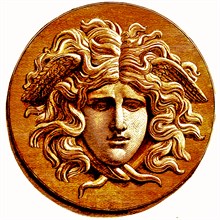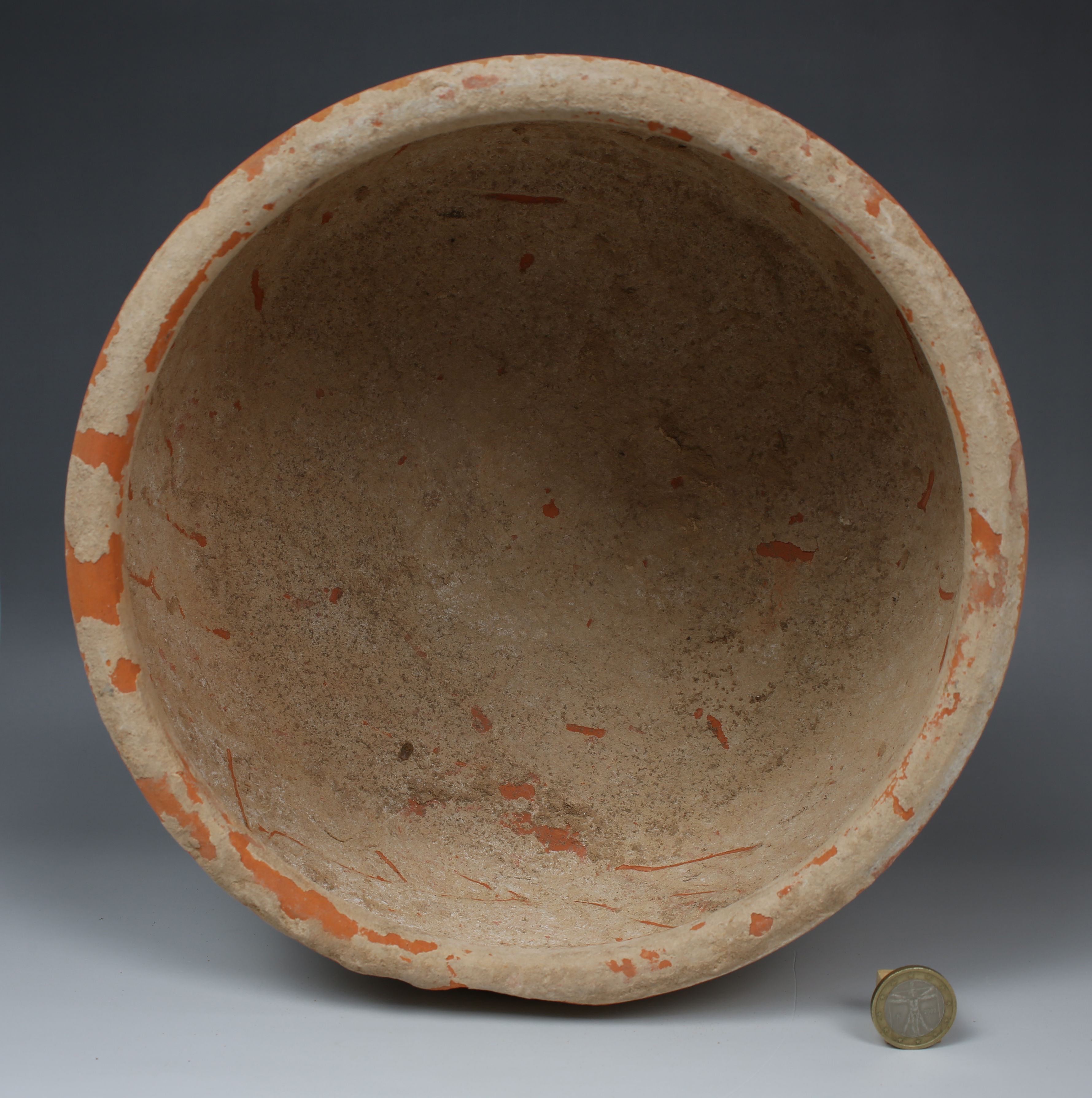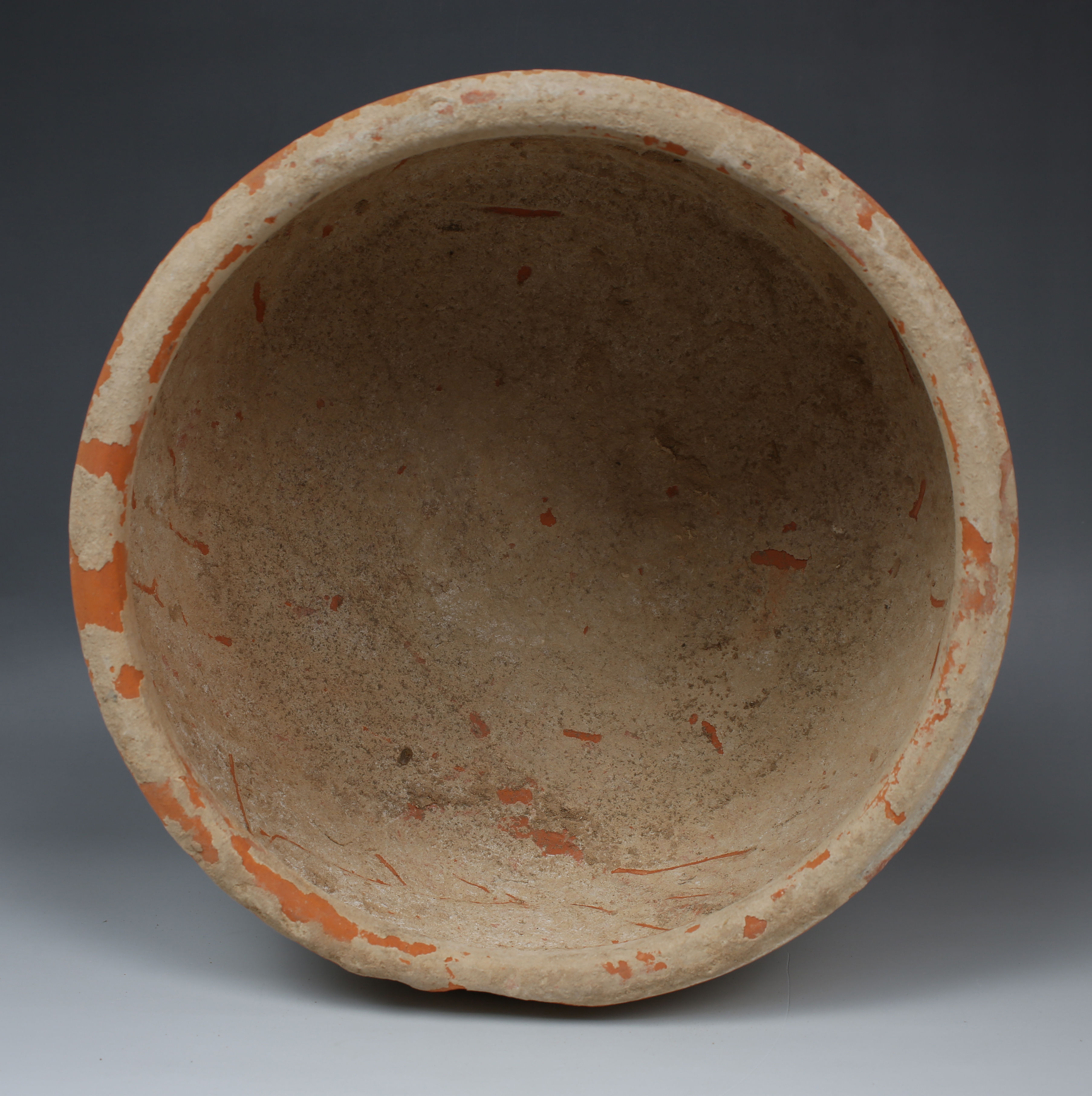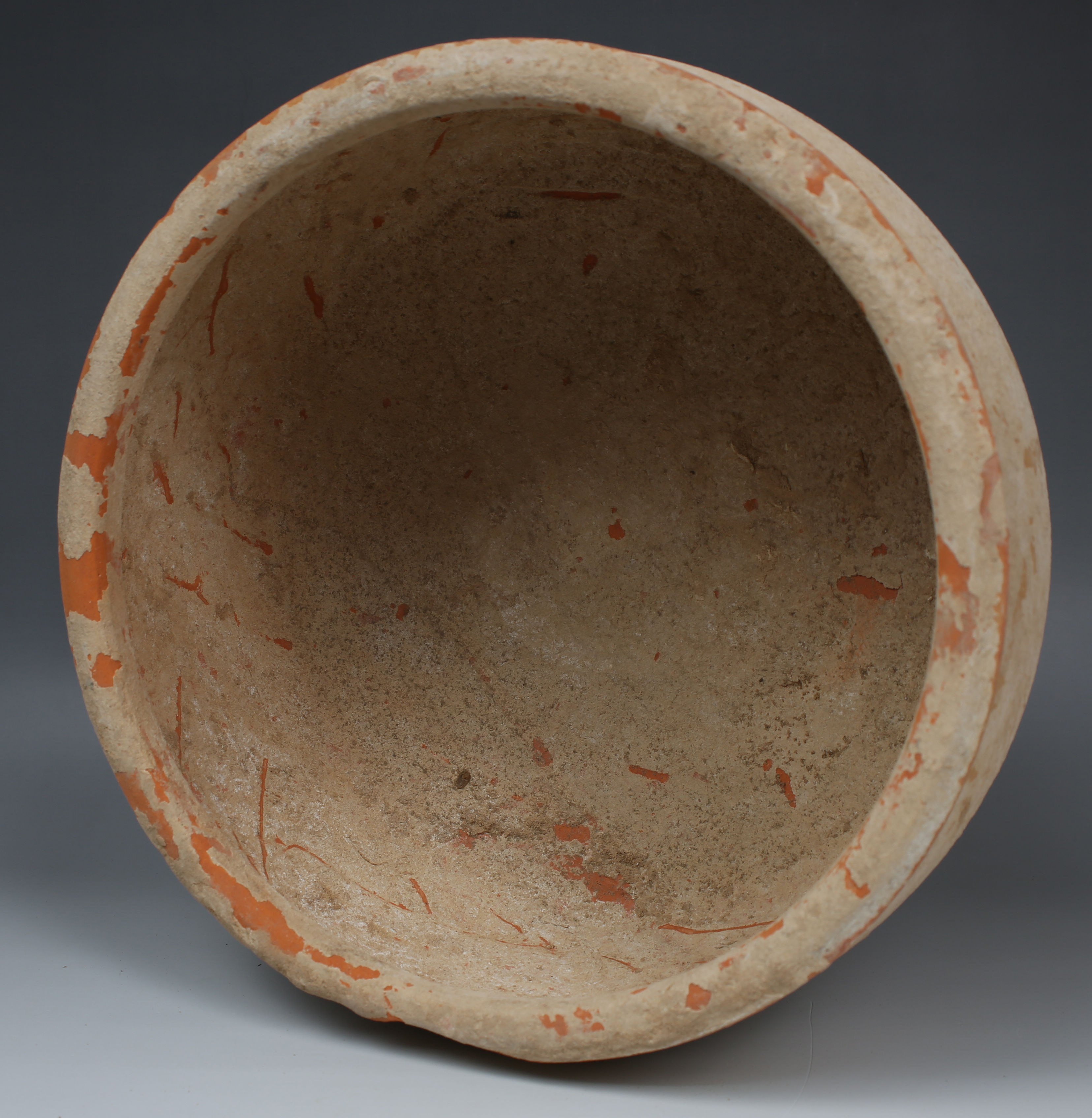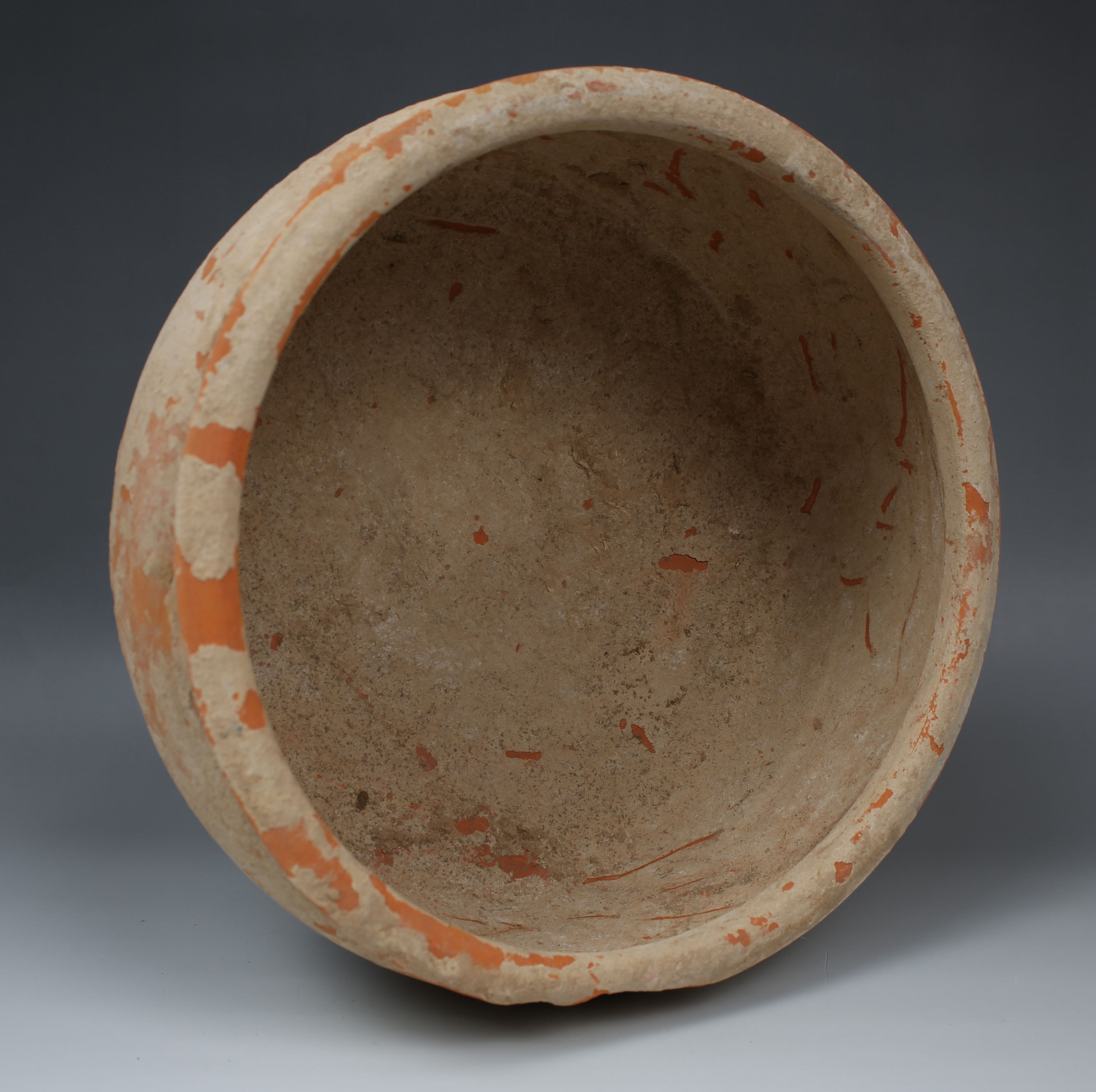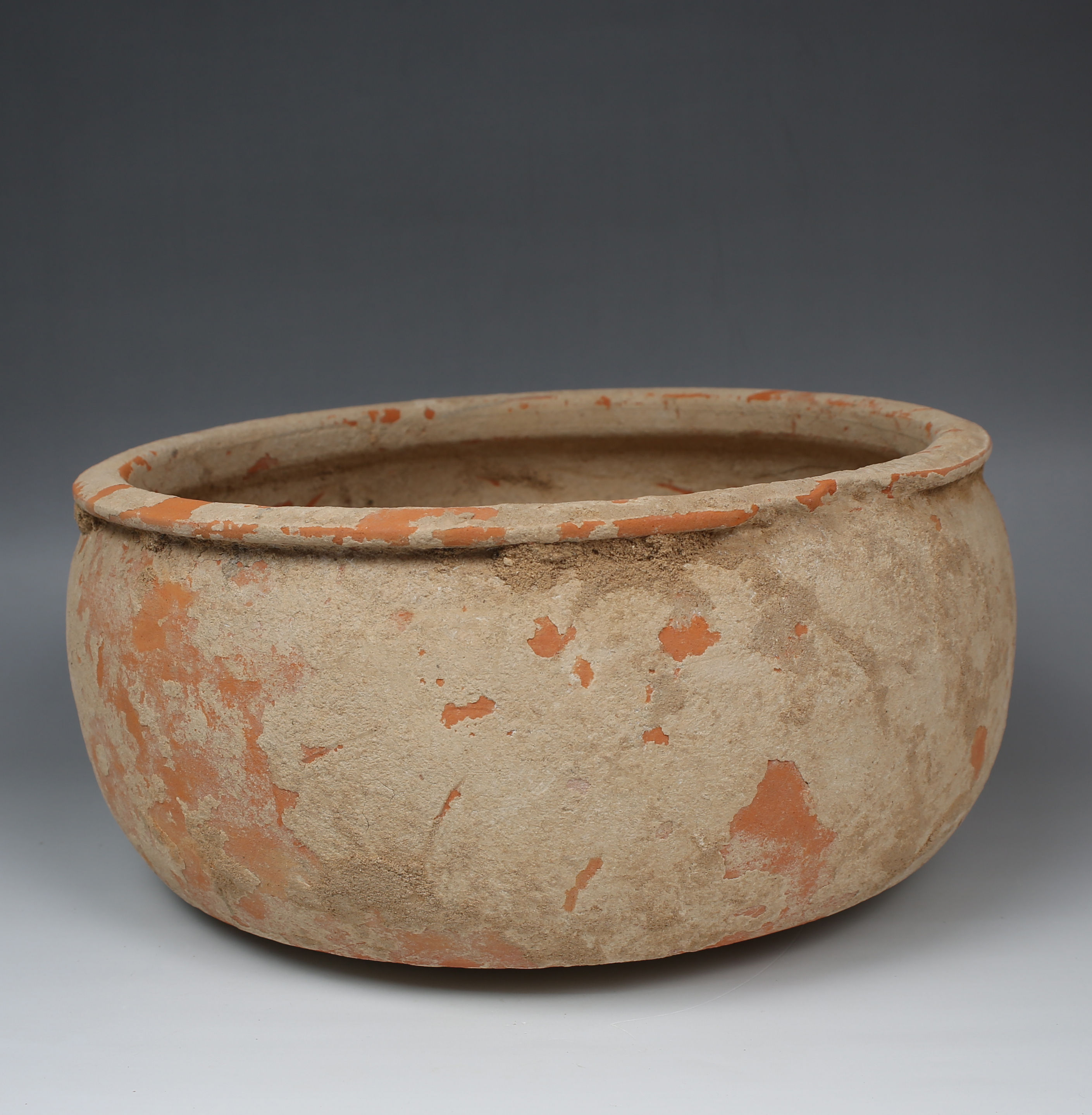156
Roman vessel
MATERIAL: Pottery
CULTURE: Roman
PERIOD: 1st - 3rd Century A.D
DIMENSIONS: 110 mm x 253 mm diameter
CONDITION: Good condition
PROVENANCE: Ex French private collection, acquired before 1990s
Comes with Certificate of Authenticity and Export Licence. If you are from outside the European Union, we will have to apply for the export licence again for your country, this takes 4 to 6 weeks and has a cost of 5% of the amount of the sale, this amount will be added to the final invoice.
Roman vessels, encompassing a wide range of pottery, glass, and metalwork, were integral to daily life in ancient Rome. These vessels served diverse functions, from holding food and liquids to being used in religious rituals and burial practices. Common pottery vessels, such as amphorae, dolia, and craters, were made primarily of terracotta and were used to store and transport wine, oil, and grain. The mass production of these vessels, particularly in workshops across Italy, Gaul, and North Africa, made them widely available throughout the Roman Empire. Their designs ranged from simple utilitarian forms to more elaborate, decorated pieces, often featuring reliefs, inscriptions, and painted designs that depicted mythological scenes, daily life, and symbols of power.
Glass vessels, which became increasingly popular during the Roman Empire, were a significant advancement in Roman craftsmanship. Techniques like glassblowing, developed around the 1st century BCE, allowed for the mass production of delicate glass cups, bottles, bowls, and vases. These vessels were prized for their transparency and ability to capture light, making them especially popular among the elite for dining and display purposes. Many Roman glass vessels were decorated with intricate designs, including molded patterns, applied trails of glass, and even gilded details. Glass became a symbol of luxury, and its widespread use in the empire helped shape Roman aesthetic preferences, from simple everyday drinking cups to elaborate decorative pieces found in wealthy households and tombs.
Roman metal vessels, often made from silver, bronze, or pewter, were primarily used for ceremonial purposes, including religious rituals and banquets. Silverware, in particular, was a status symbol and was often intricately decorated with motifs that reflected the wealth and cultural influences of the owner. Metal vessels were also crafted in specialized forms for specific functions, such as calices (chalices) for drinking wine during rituals or patera (shallow bowls) used in sacrifices to the gods. Many of these metal vessels were finely engraved or repoussé, showcasing the skill of Roman artisans.
MATERIAL: Pottery
CULTURE: Roman
PERIOD: 1st - 3rd Century A.D
DIMENSIONS: 110 mm x 253 mm diameter
CONDITION: Good condition
PROVENANCE: Ex French private collection, acquired before 1990s
Comes with Certificate of Authenticity and Export Licence. If you are from outside the European Union, we will have to apply for the export licence again for your country, this takes 4 to 6 weeks and has a cost of 5% of the amount of the sale, this amount will be added to the final invoice.
Roman vessels, encompassing a wide range of pottery, glass, and metalwork, were integral to daily life in ancient Rome. These vessels served diverse functions, from holding food and liquids to being used in religious rituals and burial practices. Common pottery vessels, such as amphorae, dolia, and craters, were made primarily of terracotta and were used to store and transport wine, oil, and grain. The mass production of these vessels, particularly in workshops across Italy, Gaul, and North Africa, made them widely available throughout the Roman Empire. Their designs ranged from simple utilitarian forms to more elaborate, decorated pieces, often featuring reliefs, inscriptions, and painted designs that depicted mythological scenes, daily life, and symbols of power.
Glass vessels, which became increasingly popular during the Roman Empire, were a significant advancement in Roman craftsmanship. Techniques like glassblowing, developed around the 1st century BCE, allowed for the mass production of delicate glass cups, bottles, bowls, and vases. These vessels were prized for their transparency and ability to capture light, making them especially popular among the elite for dining and display purposes. Many Roman glass vessels were decorated with intricate designs, including molded patterns, applied trails of glass, and even gilded details. Glass became a symbol of luxury, and its widespread use in the empire helped shape Roman aesthetic preferences, from simple everyday drinking cups to elaborate decorative pieces found in wealthy households and tombs.
Roman metal vessels, often made from silver, bronze, or pewter, were primarily used for ceremonial purposes, including religious rituals and banquets. Silverware, in particular, was a status symbol and was often intricately decorated with motifs that reflected the wealth and cultural influences of the owner. Metal vessels were also crafted in specialized forms for specific functions, such as calices (chalices) for drinking wine during rituals or patera (shallow bowls) used in sacrifices to the gods. Many of these metal vessels were finely engraved or repoussé, showcasing the skill of Roman artisans.
Auction 6 of Ancient Art
Sale Date(s)
Venue Address
3. EXPORT LICENSES: All pieces have the corresponding export license to be shipped out of Spain.
3.1 For bidders from the European Union, it is not necessary to apply for any additional export license, as the one included in the piece is valid.
3.2 For bidders outside the European Union it will be necessary to apply again for an export license for your country, this usually takes from 4 weeks to 6 weeks and has a cost of 5% of the hammer price. This cost will be added to the final price of each lot purchased.
8. The shipment, in general, take place within the three days following the receipt of payment, except in cases of agreement between both parties, in which case the client will be informed of the exact date and the means of dispatch. In the case where the country of destination is not Europe, the dispatching of the piece will take place in the same conditions stated, but counting from the receipt of the corresponding export permission issued by the Spanish authorities.
8.1. If you win more than one item, we can do a combined shipment and you will not be charged extra for it, unless one of the pieces won makes shipping more expensive.
8.2. Items will be shipped only upon receipt of payment in full and will be insured for their full value. For shipments outside Europe, customs and duties may apply upon entry in to customer country, and this fee, if any, is the buyer’s responsibility. We will not falsify customs value on international shipments! If you have questions about this, please inquire before bidding.
8.3. As a guideline, for a small parcel, our courier and insured shipping rates are: 9,95 € for Spain, 24,95 € for Europe, England and Switzerland and 39,95 € for America and Asia. If its a medium parcel, 9,95 € for Spain, 24,95 € for Europe, England and Switzerland and 69,95 € for America and Asia. In case it is large, heavy or for a value of more than 1000 euros may be increased slightly from the rates shown.
8.4 For pieces that are very fragile or very large in size/weight and that can only be shipped within the European Union, United Kingdom and neighbouring countries that can be transported by road will be shipped by private courier (door to door) and the price will be 350 euros, 100 euros for Spain.
Important Information
Ancient Art at the best price respecting and strictly complying with the laws of heritage protection and UNESCO heritage norms. Affordable in-house shipping.
Terms & Conditions
1. All ancient items offered for sale have been acquired strictly complying with the laws of heritage protection and UNESCO’s heritage norms, and guaranteed to be as described.
2. Our cataloguings, descriptions and certificates has been carried in accordance with their professional experience, previous investigation and checking against similar pieces catalogued in public collections, private collections or to be found in the art market.
3. EXPORT LICENSES: All pieces have the corresponding export license to be shipped out of Spain.
3.1 For bidders from the European Union, it is not necessary to apply for any additional export license, as the one included in the piece is valid.
3.2 For bidders outside the European Union it will be necessary to apply again for an export license for your country, this usually takes from 4 weeks to 6 weeks and has a cost of 5% of the hammer price. This cost will be added to the final price of each lot purchased.
4. The bidder guarantees payment for the item(s). In case of discrepancy, the lot or lots may be offered for sale again.
5. All lots will sell to the highest bidder without hidden or confidential reserves. Prices marked as estimates (both minimum and maximum) are for reference only. The hammer price may be higher or lower depending on the demand.
6. PAYMENT POLICY: To provide a seamless bidder checkout, all winning lots will be invoiced through the system the bidder has chosen for the live auction, unless bidder chooses to pay Your Antiquarian directly via credit card (MasterCard or Visa), PayPal or Bank Wire Transfer. If bidder chooses to pay Your Antiquarian directly, bidder must contact us to arrange payment. Payments not made within 15 days of auction’s end will forfeit bidder’s right to purchase said item(s), with item(s) relisted to next appropriate auction.
6.1 If the customer wishes to pay through our website, we will generate a payment link and the customer can choose the payment method that is most suitable, payment by Credit Card (MasterCard, Visa or American Express), Bank Transfer or PayPal. Payment with PayPal is subject to an increase of 3% of the invoice.
7. BUYER’S PREMIUM: A 8% Buyer’s Premium will be added to the final price of each lot purchased.
8. The shipment, in general, take place within the three days following the receipt of payment, except in cases of agreement between both parties, in which case the client will be informed of the exact date and the means of dispatch. In the case where the country of destination is not Europe, the dispatching of the piece will take place in the same conditions stated, but counting from the receipt of the corresponding export permission issued by the Spanish authorities.
8.1. If you win more than one item, we can do a combined shipment and you will not be charged extra for it, unless one of the pieces won makes shipping more expensive.
8.2. Items will be shipped only upon receipt of payment in full and will be insured for their full value. For shipments outside Europe, customs and duties may apply upon entry in to customer country, and this fee, if any, is the buyer’s responsibility. We will not falsify customs value on international shipments! If you have questions about this, please inquire before bidding.
8.3. As a guideline, for a small parcel, our courier and insured shipping rates are: 9,95 € for Spain, 24,95 € for Europe, England and Switzerland and 39,95 € for America and Asia. If its a medium parcel, 9,95 € for Spain, 24,95 € for Europe, England and Switzerland and 69,95 € for America and Asia. In case it is large, heavy or for a value of more than 1000 euros may be increased slightly from the rates shown.
8.4 For pieces that are very fragile or very large in size/weight and that can only be shipped within the European Union, United Kingdom and neighbouring countries that can be transported by road will be shipped by private courier (door to door) and the price will be 350 euros, 100 euros for Spain.
9. RETURN POLICY: We have a no quibble 90 days return policy. We accept returns for any reason within 90 days of you receiving your item. The item(s) must returned in the same conditions in which the received (no damage or deterioration). The expenses that could derive from the return (transport, insurance, etc) will be at the expense of the buyer.
10. On the prevention of money laundering or terrorist financing, according with directive (EU) 2015/849 and 2018/843, all clients will be asked to provide proof of identification (valid passport, driving license, ID card and a proof of address) when purchasing or selling art works valued 10.000 € or more in a single or linked transaction. If you represent a company you will need to provide details of directors, evidence of incorporation and the ultimate beneficial owners.
11. QUESTIONS: For any questions, before / during and after the auction, feel free to email us: admin@yourantiquarian.com or a Whatsapp to the number +34 644811359. We will be happy to help you in any way we can.
Last update: September 28th, 2024










